We all know that the more that students sight-read, the better they will be able to read music. However, with so many sight-reading books on the market, it’s hard to know which is the best for your studio.
I’ve recently decided that for a sight-reading book to be useful, it must be:
All this can now be found in one simple package, the Piano Adventures Sight-reading series – in my opinion, the best sight-reading books on the market. There are four levels in the series and all are very reasonably priced.
While it might be easy to give a student a sight-reading book and say ‘Go for it’, they are not going to improve without instruction. In my opinion, it’s vital to teach sight-reading skills.
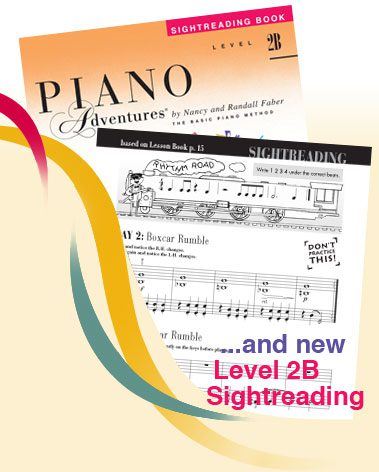
© Copyright 2013 Dovetree Productions Inc
Pattern and interval recognition is where sight-reading should start. When we sight-read, we need to be able to read the words in music and not just the letters. I give my students the analogy of learning to read: when you learn to read the word “cat”, you say the syllables out loud: “c – a – t” before you put it together and learn to just say “cat” when you see the word.
In a similar way, many students sight-read music note-by-note (just like reading this whole sentence letter-by-letter), rather than recognising the patterns, intervals, shapes and structures inherent in the composition.
I was interested to read a great article by Erica Sipes entitled: Tapping into the video game world when practising:
Part of the key to being successful in Tetris is learning how to spot patterns quickly and knowing what to do with them. If I don’t try to learn about the patterns while playing, and figure out how to quickly deal with how the different patterns interact with one another, I don’t really have a strategy. It’s more like I am just randomly trying to deal with each individual piece which doesn’t usually work very well and tends to tire me out very quickly. In music, if I persistently approach each individual note as an individual note, learning a piece of music is like climbing Mt. Everest. Each individual step is painful and taxing both mentally and physically.
It’s just the same with sight-reading: recognising shapes, patterns and structures should be the first step to musical comprehension at the piano. For example, one of the first structures I get my students to read and play is a triad:
These are easy to spot because the notes are stacked line-line-line or space-space-space (whether blocked or arpeggiated) and they all feel the same to play. At this stage, students always use the same fingering (either 1-2-3 or 1-3-5). Similarly, I get them to recognise 5ths (played with 1-5 and generally about the width of a hand), which are just triads without the middle note, also both on lines or in spaces:
I drill students on their ability to play intervals regularly so that they know how these shapes “feel” in their hands and which fingers to use. This is a vital part of reading fluently. The next interval to recognise and drill is a 3rd (using either/or 1-3, 2-4 or 3-5 fingers) as they are also on adjacent lines or in adjacent spaces and therefore easy to spot:
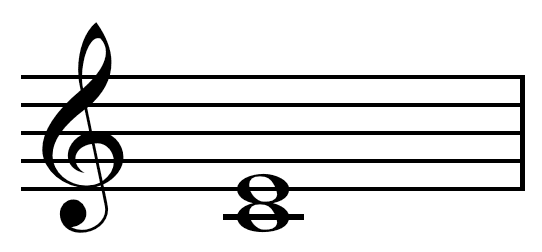
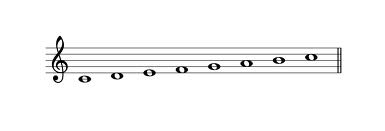
Boogie-woogie/blues patterns:
or the “root-5-root” pattern so common to modern film and pop music (and that I use for composition work with my teen and adult students), which is just an octave with a 5th in the middle:
Student should be able to spot and play these instantly. When they can recognise broken chords, arpeggios, scales, root position triads and intervals, we’ll generally add chord inversions. At the same time, we’ll be developing our understanding of chord progressions and harmony so that they can start to guess the movement of the LH before it even happens! Learning standard progressions like the 12-bar-blues is also really useful.
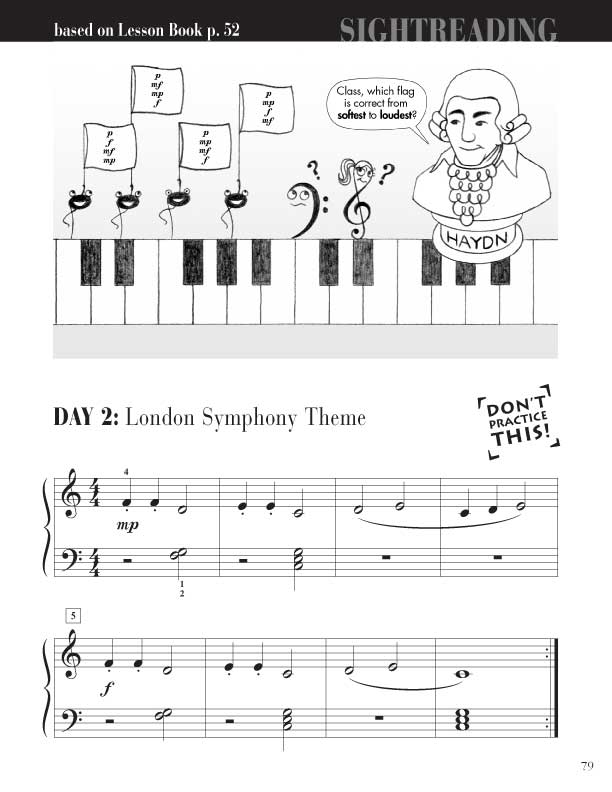
© Copyright 2012 Dovetree Productions Inc c/o Faber Piano Adventures 3042 Creek Dve, Ann Arbor, MI 48108 Used By Permission of Hal Leonard Australia Pty Ltd. All Rights Reserved. Unauthorised Reproduction is Illegal.
This way of teaching sight-reading is, in my opinion, the fastest and most secure way of developing a student’s reading ability. The great thing about the Piano Adventures series is that each piece tests the recognition of exactly these structures in a graded, repetitive manner. Take a look at the page on the right or have a look inside the level 2A book to get an idea of what I’m talking about.
Notice also the “Don’t Practice This!” sign to remind students that this is just sight-reading and they shouldn’t be ‘learning’ the music. There is also a repeat sign at the end of each piece to give students one more chance to improve their playing.
There is also a nifty instruction at the start of the book that says students should cross out each piece when they’ve played it. My kids find this really satisfying and it also makes it easier for teachers to track their students’ progress.
Of course, learning about scales, keys, expected chord structures (via the Circle of 5ths) are all very important too, but the fastest way to improve reading is to learn to read musical words (ie. musical structures and patterns) rather than letters (individual notes).
The other great challenge in teaching sight-reading is making sure students don’t stop when they make mistakes. The best way to do this is to either have the students accompany another instrument or voice (which can be logistically impossible), or use the great sight-reading app by Wessar which I’ve previously blogged about. This app removes the bars that students have played so they have no option but to keep going. I also find that tapping the beat and singing the tune, while thoroughly annoying for the student, is great for keeping them going.
If you’d like more information, leave a comment and I’ll be sure to post more information in the future.
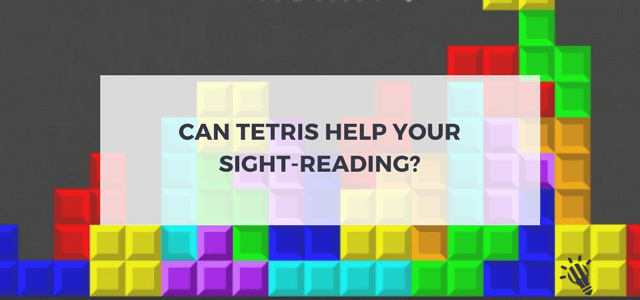
Tetris, an ugly bump, and sight-reading | LaDona's Music Studio says:
[…] snapped to attention when I saw Tim Topham’s post “Can Tetris help your sight-reading?” It’s all about pattern recognition, manipulation of the patterns, all done at an […]
kaylynnlowry says:
I am definitely going to check out these books. Thanks!
Rebecca, www.sightreading.com.au says:
Something that made me excellent at Tetris was the fact I spent hours on it! (I remember as a teenager going to sleep with blocks in my mind, spinning them into the perfect position.) Students and parents need to embrace the “quantity” mindset and enjoy playing new music as often as possible. This includes duets – get them to play with others in the early stages of learning a duet so they are forced to continue without pauses. Playing around with transposition and keyboard harmony as well as transcribing their own compositions are also really fun ways to build understanding of how music is written and read.
timtopham says:
Hi Rebecca – love your thoughts. Thanks for the comment. Totally agree that duets are another great way to “force” students to keep going – I use them regularly as well. I don’t get students to write their music all that much – I’ve tried and found that it’s incredibly hard going for them, even if the music is reasonably simple. Do you have special ways to tackle this?